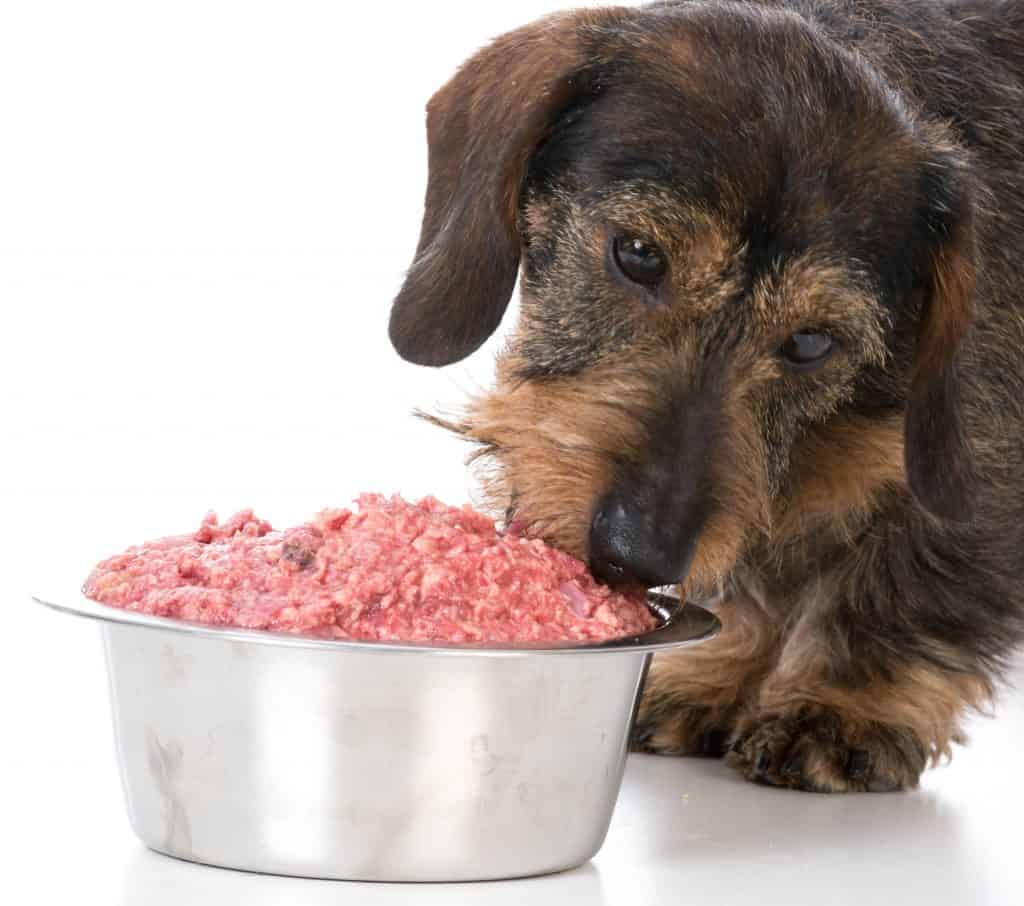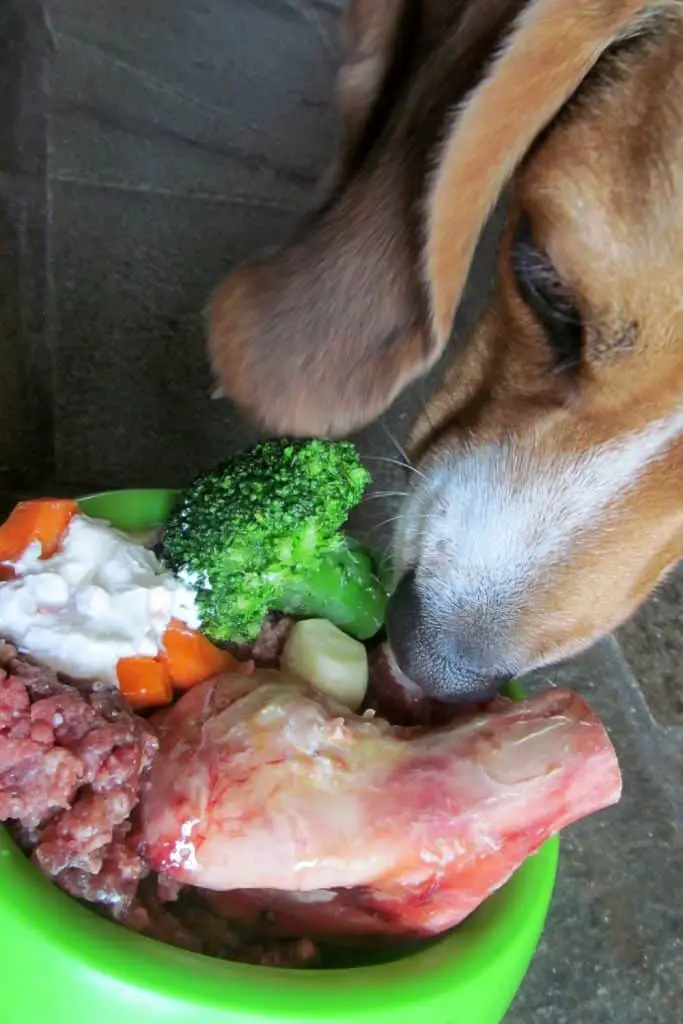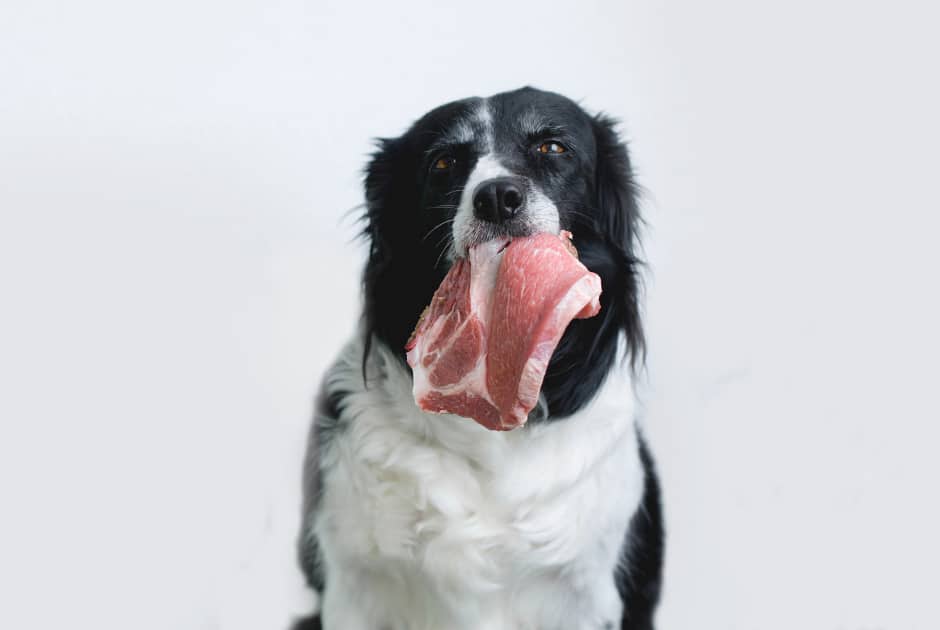Updated: 02/15/2023
Are you considering switching to a raw food diet for your furry friend? Great choice! Raw food offers a whole lot of health benefits for dogs. But the big question on every dog owner’s mind is, ‘How much raw food should I feed my dog?’
The answer is it depends. Just like us humans, every dog is different. Luckily we have a handy chart down below. Some are petite while others are hulking beasts, and their activity levels can vary from couch potato to marathon runner. So, when figuring out how much raw food to feed your dog, you’ll need to consider all these factors.
Don’t worry, though – we’ve got you covered. We’ve put together a simple guide to help you determine how much raw food your furry friend needs. Of course, if you have a puppy, there are separate guidelines. But for the grown-up pups out there, let’s get started!
Remember to always check with your vet before making these big decisions.
How Much Raw Food To Feed Dog?
Okay, now you know that the amount of raw food your dog needs depends on their weight and activity level. As a general rule of paw, dogs need between 2 to 3 percent of their weight in pounds converted to raw dog food. So, their food intake will differ if your pup is a chunk or a supermodel. If your dog acts like a tornado or a couch potato like a sloth, you’ll need to adjust its food intake accordingly.
For instance, let’s say your dog is a moderately active adult weighing 30 pounds. In that case, they’ll need between half a cup and one cup of raw dog food daily. And you don’t want to make them wait all day for their meals. So, it’s best to split their daily food into two meals. Give them one in the morning and another in the evening to keep their tummy from growling.
Remember, if you’re unsure how much to feed your furry friend, you can consult your veterinarian. They’ll give you exactly how much to feed your dog. Also, you can check out the feeding guidelines of big-name commercial raw dog food brands. And if you want a visual aid, check out our raw dog food chart below. It’ll give you a barktastic idea of how much to feed your pup based on their weight.
Raw Dog Food Chart
| Size | Weight | Amount |
|---|---|---|
| Toy | 4-10 pounds | 0.64 ounces to 1.6 ounces |
| Small | 11-35 pounds | 1.76 ounces to 5.6 ounces |
| Medium | 35-65 pounds | 5.6 ounces to 10.4 ounces |
| Large | 65-90 pounds | 10.4 ounces to 14.4 ounces |
| Extra Large | 90-120 pounds | 14.4 ounces to 19.2 ounces |
How Much Raw Food to Feed a Puppy?
Puppies are mini whirlwinds with tails that need a lot of fuel to grow. So, when it comes to feeding your little pup, it’s a whole different ball game than feeding an adult dog.
Puppies need a higher percentage of raw dog food than their older counterparts, and their food requirement is based on their age. As they age, they’ll eat a lower percentage of their weight in pounds for food. But let’s focus on the puppy phase, shall we?
For instance, if your pup is between 2 to 3 months old, it’ll need 8% to 10% of its weight in pounds for food. As they get older, say between 4 to 5 months, that percentage drops to 6% to 8% of their weight in pounds for food.
By the time they reach 6 to 8 months, it’s down to 4% to 6%, and from 9 months to one year old, they’ll need 3% to 4% of their weight in pounds for food.
Now, I know what you’re thinking. How am I supposed to measure all that? And don’t worry; you don’t have to be a math wiz to figure it out. Just use a good old-fashioned kitchen scale. And remember, puppies have teeny-tiny stomachs, so it’s best to split their food into even smaller meals, preferably 3-4 small meals throughout the day.
Oh, and one last thing. Do it gradually when you switch your pup to a raw food diet. You don’t want your little buddy to have a tummy ache or sudden surprises. So, take it slow, and soon enough, your pup will be chowing down on that raw goodness like a champ.
Do the Four Day Switch
Transitioning your dog to a raw food diet can be exciting but challenging, and the four-day switch will make it easier for your furry friend to adjust. Following this plan, your dog can switch to its new raw food diet smoothly.
Give your dog a small spoonful of raw dog food on day one. You can even give it to your dog on a spoon as a special treat. Mix it with your dog’s regular food so that it can start getting used to the taste and texture.
On the second day, replace a quarter of your dog’s food with raw diet food. Serve it alongside your dog’s existing food.
On the third day, replace half of your dog’s daily food intake with the raw food diet. Mix it with the other half of your dog’s food and serve them together.
Finally, on the fourth day, your dog has made it to the end of the transition period and is ready to enjoy a full raw dog food diet. Your dog’s digestive system will have had enough time to adjust to the new diet, and it will be much easier on your dog’s stomach.
Remember that every dog is unique and may require different times to adjust to the new diet. If your dog experiences any digestive issues, consult your veterinarian. They will provide the best guidance to help your dog transition to a raw food diet.
What Raw Foods Should I Feed my Dog?
If you’re thinking of feeding your dog a raw food diet, you’ll be pleased to know that plenty of delicious options are available. From lean meats to green vegetables, there are a variety of foods that are not only yummy but also packed with essential nutrients.
First up, lean meats like chicken, beef, turkey, pork, venison, and lamb are all excellent sources of protein your dog needs to stay healthy. They help with everything from building strong muscles to maintaining a healthy weight.
Next, animal organs like the liver and heart are packed with vitamins and minerals your dog needs to thrive. Raw bones are also a great addition to your dog’s diet, as they help keep teeth clean and strong.
Green vegetables like spinach, mixed greens, and broccoli are rich in essential vitamins and minerals that support your dog’s overall health. Veggies like carrots, beets, and parsnips are also great for adding variety to your dog’s diet.
Adding oils or omegas to your dog’s diet can also help improve their skin and coat health. Olive oil, liver oil, and sunflower oil are great options.
While not as essential, fish like salmon, herring, and sardines, dairy products like goat’s milk, and whole eggs, and fruits like apples, bananas, and watermelon can all be added to your dog’s raw food diet to provide additional nutrients and flavor.
So why not mix it up and try out some of these delicious options for your furry friend? They’ll thank you for it with wagging tails and happy barks!
How Long Does Raw Dog Food Last in the Fridge?
It is not recommended to leave raw food out for more than 30 minutes as it can quickly become contaminated with harmful bacteria. If your dog doesn’t finish its food within 30 minutes, it is best to discard it rather than risk your dog getting sick from eating spoiled food.
If you do need to store leftover food, make sure to cover it and place it in the refrigerator right away. It is also important to clean your dog’s food and water bowls after each meal to prevent bacteria buildup.
Is It Expensive to Feed a Dog a Raw Diet?
Feeding raw dog food can be more expensive than traditional dry dog food, but it can also depend on various factors, such as where you live, the quality of the ingredients, and the amount your dog needs to eat. While purchasing premade raw dog food from a company may be more costly, making the food yourself can help reduce costs. You can also consider buying in bulk or taking advantage of sales and discounts to save money.
It’s important to consider the overall cost and benefits of a raw dog food diet for your individual dog. While it may have some health benefits, it’s always a good idea to consult with your veterinarian before making any major changes to your dog’s diet.
So the question of How much raw food to feed a dog might come from a financial decision.
Can I Feed my Dog Raw Meat from the Grocery Store?
It’s important to note that when feeding your dog meat from the grocery store, it’s important to handle it safely to avoid any potential contamination or foodborne illness. Make sure to wash your hands thoroughly before and after handling raw meat, and use separate cutting boards and utensils for your dog’s food to avoid cross-contamination with human food.
Additionally, it’s important to ensure the meat is cooked to a safe internal temperature to kill harmful bacteria. If feeding raw meat, make sure to follow safe handling practices and do your research on potential risks and benefits before starting a raw diet.
Which Raw Meat is Best for Dogs?
Hey there, woof woof! Are you wondering which raw meat will make your furry friend’s tail wag delightfully? Let me tell you; it’s all about finding the perfect cut.
Just like humans, dogs need their food in bite-sized pieces. So, grab that knife and get to chopping! And hey, if you’ve got a small pup, you might want to break out the magnifying glass too.
But here’s the real meaty scoop: go for lean cuts unless you want your pup to end up with a case of the runs or a bellyache. Trust me; your doggo won’t be the only one howling in pain if you ignore what you’re serving.
Conclusion
Alrighty, folks, we’ve come to the end of this kibble-licious discussion. So, how much raw food to feed a dog? Let’s paw-nder on that for a moment.
Why not drop a comment below and tell us how much meaty goodness your doggo scarfs down? And more importantly, does your pup go barking mad for a raw food diet?
But hold your leash, don’t forget that the amount of chow your furry friend needs will depend on their breed size. And if you’re looking to save some bones, why not yap it up with your local butcher for some sweet deals on meat?
And here’s a pro tip for you: to keep your pup’s tummy happy and healthy, don’t forget to mix in some veggies, healthy fats, and omega-rich oils with their lean meats. Woof, that’s some good eats!




